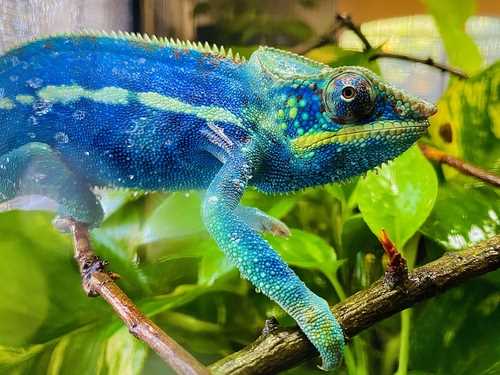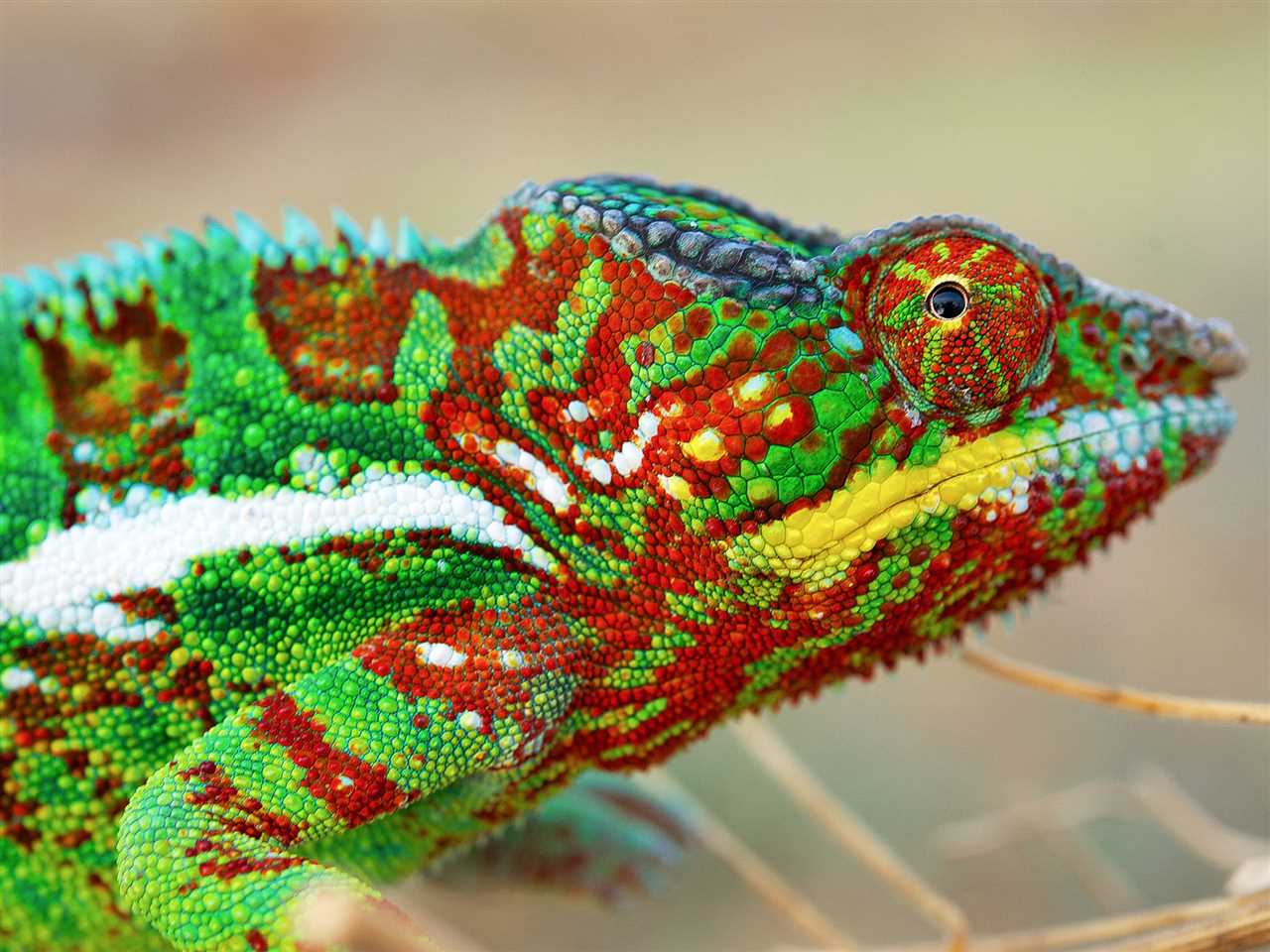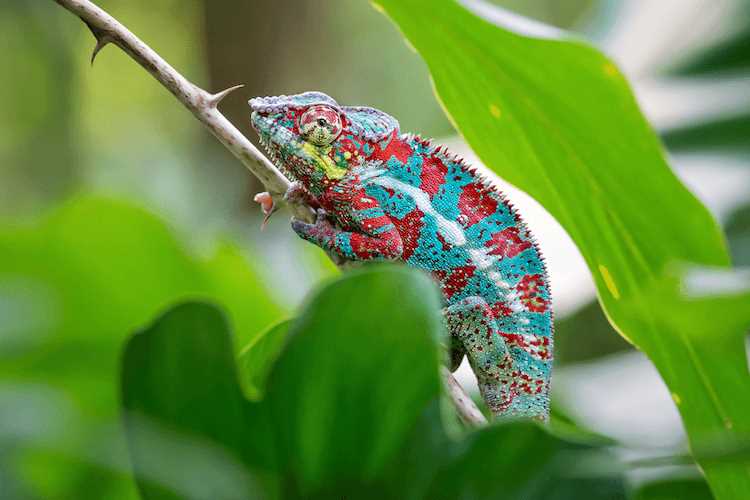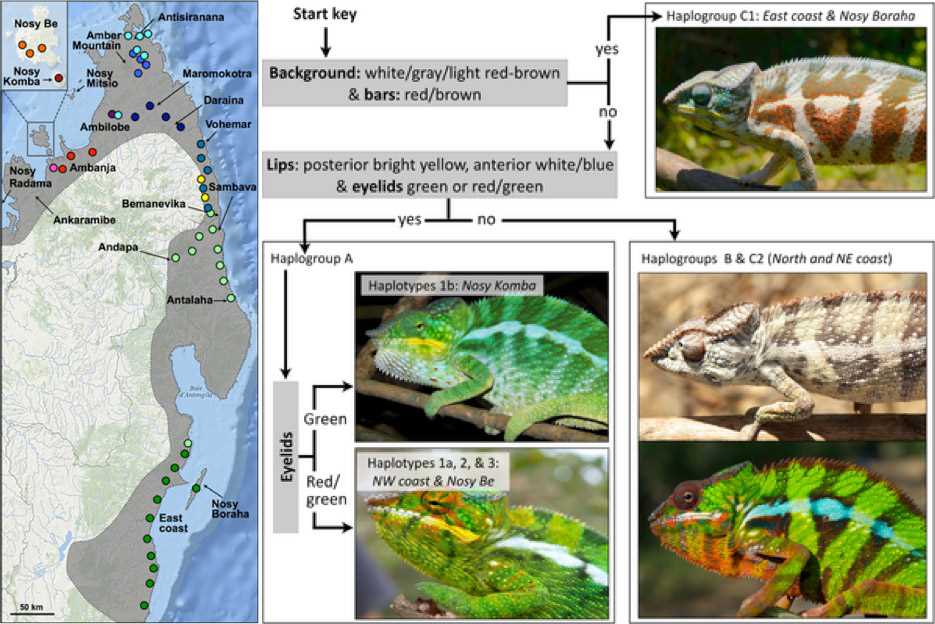
The rainbow is often seen as nature’s ultimate display of colors, but the panther chameleon gives it a run for its money. This remarkable lizard, native to Madagascar, is known for its incredible ability to change colors, making it one of the most fascinating reptiles on the planet.
Chameleons, in general, are well-known for their color-changing capabilities, but the panther chameleon takes it to a whole new level. Its ability to adapt its coloration to match its surroundings is not only a remarkable feat of nature, but also a crucial survival mechanism. By blending in with its environment, the panther chameleon can evade predators and sneak up on unsuspecting prey.
What sets the panther chameleon apart from other chameleon species is its vibrant and stunning range of colors. From deep blues and fiery reds to bright yellows and rich greens, this reptile boasts an impressive palette. Whether it’s a display of dominance, courtship, or camouflage, the panther chameleon’s ever-changing hues are simply breathtaking.
But how exactly do they change colors? The secret lies in specialized cells in their skin called chromatophores. These cells contain pigments that can expand or contract, which in turn determines the color and pattern of their skin. Additionally, the panther chameleon can control the movement and intensity of light that reflects off its skin, further enhancing its ability to create dazzling displays.
The Vibrant World of Panther Chameleon Colors
The panther chameleon is a fascinating reptile known for its vibrant array of colors. With its tongue-like tongue, it is a master of adaptation, blending into its surroundings and surprising its prey or predators. The panther chameleon’s colors are like a kaleidoscope, creating a rainbow of hues that range from bright blues and deep reds to stunning yellows and oranges.
An Assortment of Colors and Patterns
The panther chameleon displays an incredible assortment of colors and patterns that are unique to each individual. These vibrant displays are not only visually striking but also serve important purposes such as communication, behavior signaling, and thermoregulation.
The intricate patterns and coloration of panther chameleons are primarily determined by the pigments present in their skin cells. These pigments come in the form of melanin, carotenoids, and structural colors. A combination of these pigments creates the mesmerizing color variations seen in panther chameleons.
The Intricate Process of Color Change

One of the most remarkable features of panther chameleons is their ability to change their colors. This color change occurs due to a complex process involving the manipulation of pigments within the skin cells.
Contrary to popular belief, panther chameleons do not change their colors to blend in with their surroundings. Instead, color change is primarily a response to changes in temperature, light, mood, and social interactions. It is a form of expression that allows panther chameleons to communicate with other members of their species and establish dominance.
When a panther chameleon changes its colors, the pigment cells within the skin contract or expand, altering the concentration and positioning of the pigments. This results in a new color combination that can be strikingly different from the chameleon’s original appearance.
Overall, the vibrant colors of the panther chameleon not only make it a visually captivating reptile but also showcase the incredible adaptability and intricate biology of this extraordinary creature.
An Assortment of Colors and Patterns
The Panther Chameleon is a fascinating lizard species known for its incredible ability to change colors. With its striking appearance and distinctive patterns, this reptile has captivated the attention of scientists and nature enthusiasts alike.
One of the most remarkable aspects of the Panther Chameleon is its wide range of colors. These vibrant hues serve various purposes, including communication, camouflage, and temperature regulation. From deep greens and fiery oranges to bright blues and rich reds, the color palette of the Panther Chameleon is truly awe-inspiring.
Each chameleon boasts a unique combination of colors and patterns, making them highly recognizable. The patterns on their skin can range from intricate stripes and spots to elaborate geometric shapes. These patterns not only contribute to their striking appearance but also aid in their camouflage and adaptation to their surroundings.
The color change process is not solely controlled by the chameleon’s emotions but is also influenced by environmental factors. Temperature, humidity, and lighting conditions can all affect the intensity and duration of color changes. For example, chameleons often become darker to absorb more heat when basking in the sun, or they may become lighter to reflect heat and regulate their body temperature.
Another intriguing aspect of Panther Chameleon colors is the breeding for specific color morphs. Breeders have selectively bred these reptiles to produce offspring with desired color variations, resulting in striking combinations that are highly sought after by collectors and enthusiasts. This breeding process has led to an even wider spectrum of colors than those found in the wild.
One of the chameleon’s most impressive abilities is its ability to blend seamlessly with its surroundings. Through its color-changing prowess, the Panther Chameleon can camouflage itself and become nearly invisible to predators. This adaptation is crucial for its survival in the wild, as it allows the chameleon to avoid detection and ambush prey.
An interesting factor influencing chameleon colors is the role of ultraviolet (UV) light. Panther Chameleons have specialized UV-sensitive elements in their eyes, which allow them to perceive both visible and UV light. This ability may play a role in their coloration, as some pigments fluoresce under UV light, revealing even more vibrant colors not visible to the human eye.
The Intricate Process of Color Change in Panther Chameleons
One of the most fascinating aspects of Panther Chameleons is their ability to change color. This remarkable adaptation allows them to blend in with their environment and communicate with other chameleons. But how exactly does this color change occur?
At the most basic level, a panther chameleon’s ability to change color is due to specialized cells called chromatophores. These cells contain pigments that can expand or contract, resulting in different colors being displayed on the chameleon’s skin. The three main types of chromatophores responsible for color change are melanophores (black and brown pigments), xanthophores (yellow pigments), and erythrophores (red pigments).
Color change as a response to the environment
The color change in panther chameleons is not random. Instead, it is a response to various environmental factors such as temperature, light, and emotional state. When a chameleon wants to blend into its surroundings, it can adjust the pigments in its chromatophores to match the colors of the objects around it. This ability is especially useful for camouflage and predator avoidance.
For example, if a panther chameleon is perched on a green leaf, its chromatophores will contract to display more green pigments, making it almost invisible to predators. Similarly, if the chameleon is feeling threatened or agitated, it may display brighter, more vibrant colors as a warning signal.
The role of the nervous system
The color change in panther chameleons is controlled by their autonomic nervous system. This system regulates unconscious bodily functions, including the diameter of blood vessels and the activation of the chromatophores.
When a chameleon perceives a change in its environment, such as a shift in temperature or the presence of a potential mate, signals are sent from its brain to the autonomic nervous system. These signals trigger the release of certain hormones and neurotransmitters, which in turn activate the chromatophores and cause the desired color change.
In addition to the nervous system, the chameleon’s endocrine system also plays a role in color change. Hormones released by the endocrine glands can stimulate or inhibit the expansion or contraction of the chromatophores, further influencing the chameleon’s coloration.
The ability of Panther Chameleons to change color is a complex and fascinating phenomenon. Their intricate process of color change is a combination of environmental factors, the nervous system, and the endocrine system. It is a remarkable adaptation that allows these reptiles to not only camouflage themselves but also communicate with other chameleons and express their emotions through a stunning rainbow of colors.
Panther Chameleon Colors: A Stunning Display of Nature’s Hues
The panther chameleon, a magnificent reptile known for its vibrant colors, is a true marvel of adaptation and camouflage. With its ability to change its skin color, the panther chameleon showcases a rainbow of hues that captivates the eye and fascinates scientists.
This remarkable lizard possesses a primary color palette that includes vibrant blues, radiant greens, fiery reds, and rich yellows. However, these colors are not fixed but can change depending on various factors, such as temperature, mood, and environment.
The ability of the panther chameleon to change its skin color is an intricate process involving specialized cells called chromatophores. These pigment cells contain pigments that respond to external stimuli, controlling the chameleon’s coloration. When the chameleon is relaxed, the chromatophores are spread evenly, displaying a blend of colors. But when the chameleon feels threatened or excited, the chromatophores contract or expand, revealing a specific color or pattern.
Environmental factors also play a significant role in the coloration of panther chameleons. The lighting conditions and temperature of their surroundings can enhance or alter their appearance. Furthermore, the availability of UV light affects the intensity and visibility of the chameleon’s colors, making them even more vibrant and captivating.
Breeders have also contributed to the diversity of panther chameleon colors through selective breeding. By selectively mating chameleons with desired color morphs, breeders have created a wide range of color variations, such as blue bar, red bar, and blue body. These color morphs have become highly sought after by reptile enthusiasts and collectors.
One of the most fascinating aspects of the panther chameleon’s coloration is its ability to match its surroundings. Whether they are in a lush green jungle or a bright red flower, these lizards can change their skin color to blend seamlessly into their environment, allowing them to avoid detection by predators and surprise their prey.
Aside from their stunning colors, the panther chameleon’s hues also hold significance in terms of their temperament. For example, males often display brighter and bolder colors to attract females during courtship rituals or to establish dominance among rivals.
The role of UV light in chameleon coloration is another intriguing aspect. UV rays are essential for the synthesis of vitamin D, which is crucial for their overall health. Additionally, UV light helps chameleons display their colors more vividly, maximizing their chances of attracting a mate.
Overall, the panther chameleon and its colors continue to delight and captivate researchers and enthusiasts alike. Its ability to adapt its coloration to its surroundings, its diverse range of color morphs, and the intricate process of color change make it a truly fascinating creature to study and observe.
The Significance of Pigment Cells
One of the most remarkable features of the panther chameleon is its ability to change colors. This reptile, native to Madagascar, is known for its vibrant and diverse color palette that resembles a rainbow. But what is the secret behind this breathtaking adaptation?
The key lies in the chameleon’s pigment cells. These specialized cells, called chromatophores, contain different pigments that contribute to the animal’s overall coloration. The three main types of chromatophores found in panther chameleons are melanophores, xanthophores, and erythrophores.
Melanophores

Melanophores are responsible for producing black and brown pigments. These cells contain melanin, a pigment that absorbs light and gives the reptile its dark coloration. When melanin is dispersed throughout the melanophores, the chameleon appears dark, while when it is concentrated in one area, the animal appears lighter.
Xanthophores
Xanthophores are responsible for producing yellow pigments. These cells contain carotenoids, which are obtained from the chameleon’s diet. The more carotenoids the chameleon consumes, the more vibrant its yellow coloration will be.
Erythrophores
Erythrophores are responsible for producing red and orange pigments. These cells contain pteridines, a type of pigment that gives the chameleon its vibrant red coloration. The intensity of the red color can vary depending on various factors such as genetics and environmental conditions.
By controlling the distribution and concentration of these pigment cells, the panther chameleon can create a wide range of colors and patterns. Whether it wants to blend into its surroundings for camouflage or display vibrant hues to attract a mate or establish dominance, the chameleon’s ability to manipulate its coloration is truly fascinating.
Next time you observe a panther chameleon changing colors, remember the intricate process that takes place within its pigment cells. This reptile truly brings nature’s palette to life, showcasing the beauty and adaptability of the animal kingdom.
The Role of Environmental Factors in Panther Chameleon Coloration
The panther chameleon is a fascinating reptile known for its remarkable ability to change colors. This remarkable adaptation is primarily driven by environmental factors, allowing these lizards to camouflage themselves and blend into their surroundings.
Camouflage is a critical survival strategy for the panther chameleon. Their ability to change colors helps them avoid predators and become more efficient hunters themselves. By adjusting their skin pigmentation, they can match the colors and patterns of the environment they are in, making it difficult for predators to spot them.
Environmental factors such as light, temperature, and humidity play a crucial role in the coloration of these chameleons. When exposed to different types and intensities of light, their skin cells, called chromatophores, respond by expanding or contracting, affecting pigmentation and color appearance.
The Science Behind Color Change

Chromatophores are specialized cells located in the skin layers of panther chameleons. These cells contain pigments responsible for the different colors they can display. The three main pigments found in their chromatophores are melanin (brown and black), xanthophores (yellow), and erythrophores (red).
When a chameleon wants to change its color, various factors come into play. For instance, if the chameleon wants to appear brighter or more vibrant, the xanthophore cells will expand, resulting in a lighter coloration. On the other hand, if the chameleon needs to blend into a darker environment, the xanthophore cells will contract, allowing the melanin pigments to dominate and create a darker hue.
The chameleon’s color change is also influenced by its mood, temperature, and social interactions. For example, during courtship displays or territorial disputes, a male panther chameleon may exhibit brighter, more intense colors to attract a mate or intimidate rivals.
Adaptation and Survival
The ability to change colors is not just a display of beauty but a crucial survival mechanism for the panther chameleon. Their exquisite camouflage skills allow them to ambush prey or evade predators effectively. By blending into their surroundings, these chameleons can remain undetected and ensure their survival.
| Key Points: |
|---|
| – Panther chameleons have the ability to change colors as a form of camouflage and adaptation. |
| – Environmental factors such as light, temperature, and humidity influence the chameleon’s coloration. |
| – Chromatophores, specialized cells containing pigments, are responsible for color change. |
| – The chameleon’s color change is also influenced by its mood and social interactions. |
| – The ability to change colors is a crucial survival mechanism for the panther chameleon. |
Breeding for Specific Color Morphs: Unleashing the Rainbow of Panther Chameleon Colors
One of the most fascinating aspects of the panther chameleon is its ability to display a stunning array of colors. From vibrant blues and fiery reds to lush greens and striking yellows, these reptiles are nature’s living rainbow. But did you know that some of these magnificent color variations are a result of specific breeding efforts?
The process begins with identifying chameleons with desirable color traits and patterns. Once a suitable pair is selected, they are bred together to create offspring with the desired characteristics. This selective breeding process can take several generations to achieve the desired results, as certain traits may be recessive and only expressed in later generations.
One of the reasons why panther chameleons are such a popular species among breeders is their ability to produce a wide range of color variations. Each color morph possesses its own unique beauty and charm, making them highly sought after by collectors and enthusiasts.
Whether it’s a vibrant yellow body with blue bars, a deep red body with orange markings, or a striking green body with black spots, every color morph adds to the breathtaking diversity of panther chameleon colors.
This meticulous breeding process not only uncovers new and exciting color combinations, but it also helps to improve the overall health and vigor of the chameleons. By selectively breeding for specific traits, breeders can ensure that the offspring are strong and genetically diverse.
While the process of breeding for specific color morphs can be time-consuming and challenging, the end result is a panther chameleon that is a true work of art. These chameleons are living masterpieces, showcasing the incredible adaptation and evolution of these fascinating reptiles.
The Remarkable Ability of Panther Chameleons to Match Their Surroundings
One of the most fascinating aspects of the Panther Chameleon is its ability to match the colors of its surroundings. This reptile is known for its vibrant and diverse range of colors, making it a true master of adaptation in the animal kingdom.
When a Panther Chameleon feels threatened or senses danger, it undergoes a remarkable transformation, changing its skin color to blend in with its environment. This adaptation helps the chameleon avoid predators and remain concealed from potential threats.
Camouflage and Survival
Camouflage is a crucial survival mechanism for many animals, and the Panther Chameleon has taken this ability to a whole new level. By changing its colors, it can seamlessly blend into the trees, leaves, flowers, and even rocks around it. This makes it incredibly difficult for predators to spot the chameleon, increasing its chances of survival.
The color change process is controlled by the chameleon’s nervous system and is influenced by factors such as temperature, light, and the chameleon’s mood. The chameleon’s skin contains specialized cells called chromatophores, which contain pigments responsible for its coloration.
The Role of Its Tongue
In addition to its stunning ability to change colors, the Panther Chameleon also has a remarkable adaptation in its tongue. The chameleon’s tongue is long, muscular, and highly extendable, allowing it to accurately capture prey from a distance.
When the chameleon spots an insect or other small prey, it extends its tongue rapidly, causing it to shoot out and catch the prey in a matter of milliseconds. This adaptation gives the chameleon a significant advantage when hunting, making it a formidable predator in its habitat.
The Panther Chameleon’s ability to match its surroundings and its incredible tongue adaptation are just some of the many reasons why it is such a fascinating lizard. Its unique color-changing capabilities make it an incredible sight to behold in the wild, and studying these adaptations further helps us understand the complexities of nature.
The Marvelous Colors of Panther Chameleons: Exploring a Rainbow in the Reptile World
The colors of panther chameleons serve various purposes in their natural habitat. One of the most fascinating aspects of their coloration is camouflage. By blending in with their surroundings, these lizards can effectively hide from predators and become almost invisible.
The process of color change in the panther chameleon is intricate and controlled by both genetic and environmental factors. Breeding for specific color morphs has resulted in an even wider range of hues and patterns. This has made panther chameleons highly sought after among reptile enthusiasts.
Aside from their role in camouflage, the colors of panther chameleons also play a role in social interactions. For instance, males often display vibrant hues during mating rituals to attract females. The more intense and vibrant the colors, the more attractive they become in the chameleon world.
UV light also plays a significant role in chameleon coloration. It helps the reptiles to regulate their body temperature, and it affects the production of pigments in their skin. This interaction between UV light and coloration is still an area of ongoing research, but it highlights the intricate relationship between the chameleon’s environment and its appearance.
The fascination with panther chameleon colors is endless. Their ability to transform and adapt their skin color is a natural marvel that showcases the incredible diversity of nature. From their striking colors to their incredible camouflage, these reptiles continue to captivate the curiosity of scientists and reptile enthusiasts around the world.
The Connection Between Camouflage Mastery and Predator Avoidance in Panther Chameleons
Panther chameleons are renowned for their remarkable ability to blend into their surroundings through the mastery of camouflage. These unique reptiles possess a rainbow of colors that allows them to adapt to their environment, making them virtually invisible to predators.
The vibrant colors displayed by panther chameleons serve as an essential survival mechanism. By changing their skin pigmentation, they can mimic the colors of their surroundings, whether it be the vibrant greens of the forest canopy or the earthy browns and grays of a rocky terrain. This intricate coloration process is performed through the interaction of specialized cells called chromatophores, which contain pigments responsible for the chameleon’s colors.
When the chameleon senses a potential threat, it activates its incredible camouflage abilities. It may adopt a green shade to blend in with leaves or change to a reddish hue to match flower blossoms. By seamlessly blending in with its environment, the chameleon becomes nearly invisible to predators, allowing it to avoid being detected and attacked.
Furthermore, the chameleon’s ability to change colors also plays a crucial role in providing protection against predators. When threatened, the panther chameleon can change its coloration to display warning signals. It may transform into a bold and vibrant display of contrasting colors, such as bright yellows, fiery oranges, or deep blues. This dramatic change warns potential predators of the chameleon’s toxicity or intent to defend itself, deterring them from attacking.
In addition to their color-changing abilities, panther chameleons also utilize their long, muscular tongues to capture prey. With lightning-fast speed, they extend their tongues, which are coated with a sticky substance, to snatch insects and other small creatures. This highly evolved hunting technique enables the chameleon to secure food while remaining hidden from prying eyes.
The Connection Between Color and Temperament
One of the most fascinating aspects of the Panther Chameleon is its ability to change colors based on its mood and environment. This remarkable reptile is known for its vibrant and diverse coloration, which includes shades of red, orange, yellow, green, blue, and purple.
Scientists believe that the chameleon’s ability to change colors is linked to its temperament and social interactions. When a chameleon is feeling calm and content, it may display more muted and earthy tones. On the other hand, when it’s feeling threatened or aggressive, it might exhibit brighter and more intense colors.
This rainbow-hued lizard uses its color-changing ability not only for communication but also for camouflage. By blending in with their surroundings, chameleons can avoid predators and sneak up on their unsuspecting prey. This adaptation has made them masters of disguise in their natural habitat.
The Incredible Tongue and Camouflage Mastery

In addition to their stunning colors, Panther Chameleons are also known for their incredible tongues. These reptiles have impressively long tongues that they can shoot out to catch insects. This hunting technique, combined with their ability to change colors, allows them to stealthily approach their prey and strike with precision.
Chameleons can change their camouflage patterns within seconds, making it difficult for their predators to spot them. This adaptability is especially useful when navigating the dense vegetation of their rainforest habitats. Whether they need to blend into a green leafy backdrop or hide among vibrant flowers, chameleons possess the uncanny ability to modify their appearance to match their surroundings.
The Role of UV Light in Chameleon Coloration
UV light plays a crucial role in the coloration of Panther Chameleons. These reptiles can perceive ultraviolet light, which is invisible to the human eye. The presence of UV light in their environment influences both their color-changing ability and their visual communication with other chameleons.
Researchers have discovered that the intensity and pattern of UV light affect the chameleon’s coloration. This UV light not only enhances their vibrant hues but also plays a part in attracting mates and establishing dominance within their social groups.
| Chameleon Trait | Color Variation |
|---|---|
| Temperament | Muted to Bright |
| Camouflage | Adaptable |
| Tongue Length | Impressively Long |
| UV Light Perception | Influential |
Overall, the connection between color and temperament in Panther Chameleons is a fascinating topic of study. These reptiles’ ability to change colors not only allows them to communicate with each other but also plays a vital role in their survival. The rainbow of hues exhibited by these chameleons continues to captivate researchers and enthusiasts alike, providing endless fascination with the world of these incredible creatures.
The Role of UV Light in Panther Chameleon Coloration
One of the most fascinating aspects of the panther chameleon is its ability to change colors, creating a stunning display of nature’s hues. These vibrant reptiles have an intricate process of color change that is not only an adaptation for camouflage but also a way to communicate with other chameleons. While many factors contribute to their ability to change colors, one of the most significant is the role of UV light.
When a panther chameleon is exposed to UV light, these photoreceptors in their tongue become activated, signaling a change in their coloration. The chameleon’s skin contains specialized cells called chromatophores, which contain pigments responsible for their color. When the photoreceptors detect UV light, they send signals to the chromatophores, triggering them to release or absorb certain pigments.
This ability to respond to UV light allows the panther chameleon to blend in with its surroundings more effectively. It can adjust its coloration to match the UV light present in its environment, creating a more seamless camouflage. This adaptability is crucial for the chameleon’s survival, as it helps them evade predators and effectively hunt prey.
Furthermore, the role of UV light in panther chameleon coloration extends beyond camouflage. UV light also plays a significant role in social interactions between chameleons. Males, for example, can display their vibrant colors to attract females or intimidate rival males. The presence of UV light enhances the visual communication between chameleons, allowing them to accurately perceive and respond to the signals conveyed through color changes.
In addition to its important role in color change and communication, UV light also affects the overall health and well-being of panther chameleons. Exposure to UVB radiation, a specific range of UV light, enables these reptiles to synthesize vitamin D3, a vital nutrient for their metabolism and calcium absorption. Without adequate exposure to UVB light, chameleons may suffer from various health issues, including metabolic bone disease.
The Endless Fascination with Panther Chameleon Colors
The panther chameleon is a remarkable reptile known for its stunning colors and unique ability to change its skin pigmentation. These colors range from vibrant greens and blues to deep reds and oranges, creating a mesmerizing rainbow display.
One of the most intriguing aspects of the panther chameleon is its ability to camouflage. This adaptation allows the lizard to blend seamlessly into its surroundings, providing both protection from predators and a means of ambushing prey. The vibrant colors and patterns of the chameleon’s skin help it match the colors and textures of the environment, making it virtually invisible to unsuspecting eyes.
The process of changing colors in the panther chameleon is quite intricate. It involves specialized cells called chromatophores, which contain pigments that can expand or contract. By manipulating these pigments, the chameleon can alter its appearance to match its environment or display vibrant hues during courtship or territorial displays.
Camouflage Mastery and Predator Avoidance
The ability of the panther chameleon to change its colors plays a crucial role in its survival. By blending in with its surroundings, it can avoid being detected by predators such as birds and snakes. This camouflage mastery allows the chameleon to stay hidden during the day when it is most vulnerable.
Additionally, the vibrant colors displayed by the panther chameleon serve as a warning to potential predators. These bright hues indicate that the chameleon is toxic or distasteful, deterring predators from trying to eat it.
The Connection Between Color and Temperament
The coloration of the panther chameleon also plays a significant role in its behavior and temperament. Different color morphs may be associated with different personality traits, such as aggression or shyness. This makes the chameleon’s colors not only a visual spectacle but also a way to understand their individuality.
Furthermore, the panther chameleon is capable of using its colors to communicate with other members of its species. During courtship, males may display vibrant colors to attract females, while also using body movements and postures to convey their intentions.
The Role of UV Light in Chameleon Coloration
UV light plays an important role in the coloration of panther chameleons. It has been discovered that UV light can enhance the brightness and intensity of their colors, making them appear even more vibrant and eye-catching. This adaptation allows the chameleons to stand out in their natural habitats and communicate with others of their kind.

I’m Lena Adams—a product of an unconventional upbringing in the African wilderness. My father, a daring explorer of African wildlife, sparked my fascination with reptiles, a passion that intertwined with the tragic loss of my mother during an expedition, leaving an indelible mark on my life. Driven to understand the creatures that captivated my parents, I embarked on my journey, sharing insights about reptiles, frogs, and lizards on my website. Through my explorations and conservation efforts, I honour my family’s legacy while seeking connections—to the creatures, nature, and the mother whose presence I yearn to understand.
